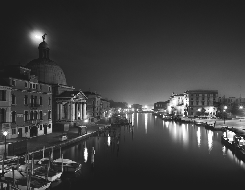Luca Campigotto
A timeless place
It was the winter of 1991, and I was a photographer in search of inspiration. In the absence of a vast frontier to explore (in my heart, Robert Adams’s Wild West, Roger Fenton’s Crimean battlefields, or the Beato brothers’ Cairo), I went out one evening with a reflex camera and attempted to take my first nocturnal photos of Venice. It was very dark and cold; I clicked the shutter just a few times, thinking that nothing would come out, and hurried back home.
It came as a surprise, the following day, when I discovered that the images I had shot conjured up a theatrical atmosphere. In the semi-transparency of the negatives, there also seemed to be a sense of humidity; the familiar sound of the water, which scarcely moves. So I borrowed a plate camera – a sole point of contact with my favourite artists—and began to systematically photograph the city.
While I was waiting for the long exposures, I wondered whether it had been a good idea to choose such a difficult subject. As a student of history, I had grown accustomed to telling the tale of Venice through the unquestionable content of archived maps and the reconstructions in great history books. But now, for the first time, I was looking at the place where I lived with the care of someone wanting to express a personal viewpoint. I was aware that the beauty of the place—its evident poetic quality—was stronger than any rhetoric. But the endless iconography that exists made it impossible to attempt a fresh approach—a renewed innocence in the way I viewed it. ‘The anxiety of capturing a landscape that can do without me’, as Joseph Brodsky wrote, came to me in the enchantment of the deserted streets.
Finally, because of my bond, I took a gamble, using as my reference the obsessive love demonstrated by the greats artists—Eugène Atget, lost in the streets of Paris; Bernardo Bellotto, who revisited Dresden again and again.
As I took one step after another, my clear awareness of the crumbling walls and canals mingled with the golden age of La Serenissima, which I had inherited from books. The scene recalled nights of long ago that I had never known.
The most humid night of the summer, sleepless and stifling, just as it was before the onset of the plague. The city emptied of its citizens, barricaded to ward off the disease. The night when the Consiglio dei Dieci gathered for a dramatic emergency council, while the sirocco raged under the porticos and the water seeped into every crevice. Or the night when the explosions and fires of the Turks ripped through the darkness, with the sinister, whirling flicker of the aft lanterns further afield, the brusque dance of the ships turning in battle.
But also many centuries of nights that unfolded without anything extraordinary coming to pass. Nights in the open air, amid the cries and coughs that rose to the palazzo windows from the jetty, crowded with fires and sails. Nights soaked in the odour of stacked Polish wood—swollen with water like corpses—beyond the walls of the Arsenale. Nights scarred by the ominous dreams of the many who, over the course of the centuries, left this place never to return. Nights of hasty decisions that changed entire lives and always seemed to come down to a matter of the Orient, a journey or an ex-lover.
And then the patrol of the ‘Signori di Notte’. The hunt for libertines fleeing through the lagoon. The moonlight shining on the gamblers. The relentless sneering of the courtesans from an illuminated balcony. The feverish work of the merchants, bent over their accounts by candlelight, eager to get to the young serving wench in the attic.
Through the photographic surface—with its ambiguous, inevitably deceptive nature – I have tried to rebuild these scenes in my imagination.
Venice is an ancient widow. Every night sickly and sublime, when she is left to herself, to the cats, to her band of rejected lovers. In the dark, her body lets itself be explored; an archive that reveals the very archaeology of the landscape, and allows us the privilege of travelling back in time.
The photographs bring the unforgettable to life. I love them because they give the illusion that we may find once again the things we have lost, or that we never possessed. A last glance can take the thing that we fear we may never see again and transform it into an icon. In the persuasive unfaithfulness of black and white, the dream is premeditated. Photography may well be nostalgia’s greatest tool.
from Venicexposed, Contrasto, Rome 2006
|
|
 |
|